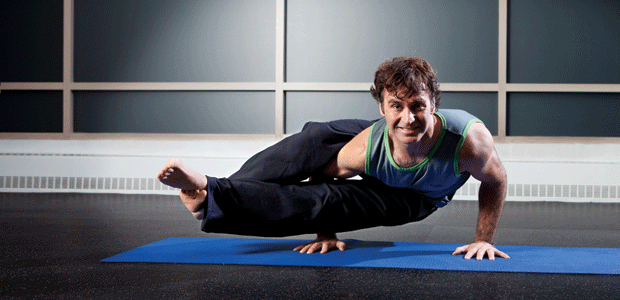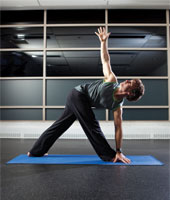
Although yoga is popular with both sexes, we introduce you to yoga poses that have specific benefits for men.
Not so long ago yoga was solely a male activity. Even as recently as the mid-19th century, yoga was taught only to men. According to ancient Hindu traditions, women were thought to reach enlightenment only in another lifetime—if they were lucky enough to be reincarnated as a man.
The famous yogi B.K.S. Iyengar opened the door when he taught not only women but also Westerners in the 1960s. Women have come to dominate the landscape of yoga classes across Canada with a ratio of 72 percent women to 28 percent men.
How can one explain this radical flip-flop of roles in less than a century?
Demographic turnaround
Perhaps there is something to the law of karma and centuries of chauvinistic male attitudes that have resulted in the current generation of men missing out on the great gift of yoga.
Or maybe it is the misconception that yoga classes are all about flexibility. Men are generally less flexible than women and have a strong desire to avoid appearing to do anything poorly.
Yoga instructors hear excuses daily from guys ranging from “The lotus pose is impossible” to “I can’t even sit on the floor” to the classic “I am just too inflexible to do yoga.” This logic makes no sense. Saying you are too inflexible to do yoga is like saying you are too dirty to have a shower! It is the perfect reason for doing something about it.
When we lose flexibility we feel old. It’s like trying to perform your daily activities while wearing spandex that is two sizes too small. You will always feel constrained, restricted, and quite simply, old.
Physical components
Flexibility is one part of yoga practice. Thinking that yoga is only about flexibility is like seeing baseball as a sport that only involves pitching. It may be a key part, but it does not represent the whole.
There are so many other components that make up this deep practice: balance, strength, coordination, and stamina to name just a few—and these are just the physical aspects.
Psychological components
There are many psychological and spiritual benefits to practising yoga. If there is truth to the stereotype that masculine energy is assertive while feminine energy is nurturing, yoga can balance these complementary qualities in a subtle but profound way.
If you practise yoga forcefully, trying to go deeper into the poses without balancing your practice with the ability to listen, there is usually just one result: injury.
The object of a yoga class isn’t to get one’s chin on one’s shin or to get the feet on one’s head but to leave the class feeling better and more vital than before the class started. This simple goal lowers the pressure to perform and makes the whole practice more approachable, therapeutic, and enjoyable.
Yoga poses for men
Take 3 long breaths to set up for each pose, moving slowly and mindfully. Hold each pose for 5 long breaths or 45 seconds.
 Downward dog Downward dog
Lie face down, place hands shoulder-width apart, and bring the knees under the hips. Spread the fingers wide and press the pelvis away from the hands, lifting the hips up, then backward, making an inverted V position. Feel the stretch in the calf muscles, hamstrings, and back. Benefits: opens hips and hamstrings; releases tension in lower back |
 |
 |
|
| easier pose | ||
|
Standing forward bend Start with feet hip-width apart and knees slightly bent. Fold forward from the hip joints, being careful not to overly round the back. Place hands on shins if need be. Slowly start to build the stretch by elongating through the torso and then straightening the legs. Lift and lengthen torso on the inhalation, and relax muscles on the exhalation. Benefits: lengthens back muscles, hamstrings, and calf muscles |
||

Triangle From standing position, step left foot back 3 1/2 ft (1 m). Keep right foot facing forward and left foot facing forward on a 45-degree angle. Spread toes and press the right foot into the floor, ensuring that the right knee is in the same plane as the right second toe. Open arms up at shoulder height, inhale and exhale, tilting the pelvis toward the right. Breathe in again and go a little deeper. Place the right hand on right shin and move head to look up at the top left hand. Feel the stretch in the right hamstring and right inner groin. Benefits: opens up the right abductor (inner thigh) and hamstring muscles; builds core stability |
|
From a standing position, step right foot back as far as feels comfortable and place weight on the ball of the foot. Keep pelvis vertical and back leg straight; press right heel back and lift the pubic bone. Feel the stretch in the quadriceps and hip flexors. Repeat on the opposite side. Benefits: opens hip flexors and quadriceps, builds core stability |
 |
 |
| easier pose | |
|
Standing pigeon Stand straight and place right ankle on left knee, keeping the shin bone aligned with the thigh bone so the knee joint is happy (imagine you have a knee brace on). Press through the heel and slowly start to bend the left leg. Press the sit bones in your buttocks and butt muscles away. If you feel more open, bring hands to the floor. Benefits: opens hips; promotes relaxation |
|

Revolved triangle Step left foot back 3 1/2 ft (1 m). Keep right foot facing forward and left foot facing forward on a 45-degree angle. Try to keep the pelvis level. Lean forward from hips and reach left hand toward the right shin. Reach with right hand high over the head. Pull left hip back, and feel the stretch in the side and waist (iliotibial band). Benefits: increases core connectivity; opens iliotibial band, side glute muscles, and obliques Note: the iliotibial band is a tough group of muscle fibres that run along the outside of the thigh. |






























 Runner’s lunge
Runner’s lunge




